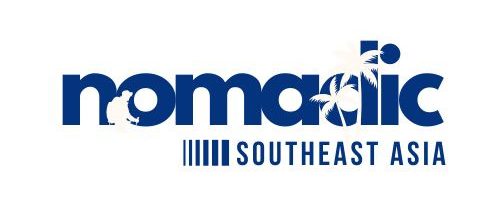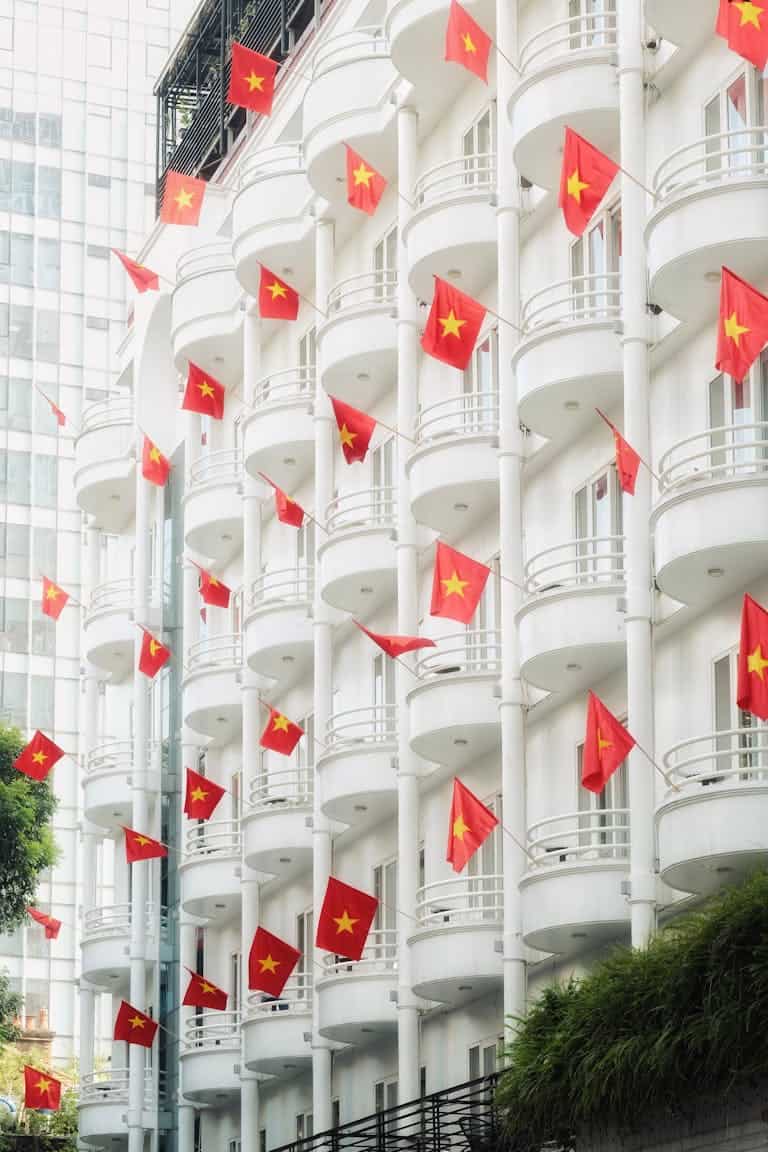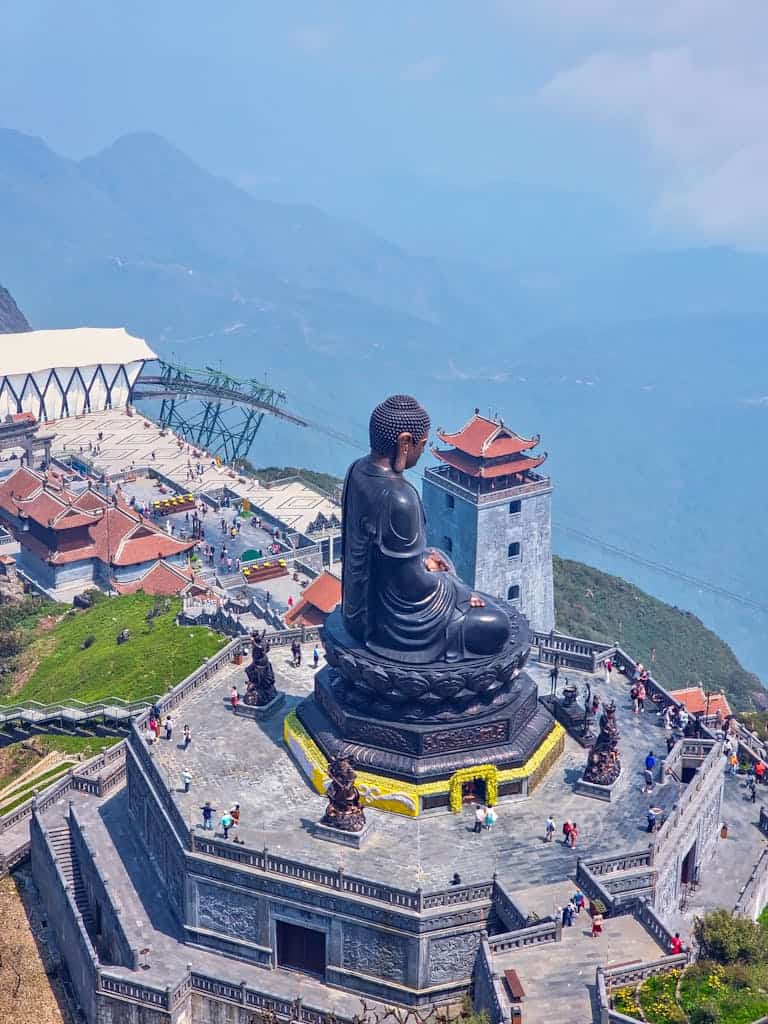Vietnam Travel Guide 2025: Complete Journey Planner
Nomadic Southeast Asia contains affiliate links and is a member of the Amazon Services LLC Associates Program. If you make a purchase using one of these Amazon links, I may receive compensation at no extra cost to you. See my Disclosure Policy for more information.

Vietnam is one of those destinations that gets under your skin and stays there, in the best way!
From the bustling streets of Hanoi to the serene waters of Ha Long Bay, this Southeast Asian gem offers experiences that’ll leave you planning your next visit before you’ve even left.
But here’s the thing about Vietnam – timing really matters, and knowing when to go can make the difference between an okay trip and an absolutely unforgettable adventure.
Key Takeaways That’ll Transform Your Vietnam Experience
- The Regional Reality Check: Vietnam stretches over 1,000 miles from north to south, which means you’re essentially traveling through multiple climate zones. What works in Ho Chi Minh City might leave you unprepared for the mountains of Sapa.
- Festival Magic: Vietnamese festivals aren’t just celebrations – they’re windows into the soul of the culture. Plan around them, and you’ll experience Vietnam like most tourists never do.
- Weather Wisdom: Those sudden tropical downpours? They’re not just inconvenient – they’re part of Vietnam’s charm. But knowing when they’re most likely to happen helps you pack smart and plan better.
- Budget Benefits: Understanding seasonal patterns helps you stretch your travel budget further and avoid the tourist traps that inflate prices during peak times.
Vietnam: Why Getting Your Timing Right Makes All the Difference?
Picture this: you’re standing in the ancient streets of Hoi An during a perfect autumn evening, lanterns glowing overhead while a gentle breeze keeps you comfortable.
Compare that to being caught in a tropical downpour without proper gear, or shivering in the northern mountains because you didn’t expect it to be quite so chilly. That’s the power of good timing in Vietnam.
Here’s what you’ll gain from planning your visit strategically:
- Comfort over chaos: Traveling during optimal weather means more time enjoying attractions and less time seeking shelter from storms
- Better value: Off-peak seasons often mean lower accommodation prices and fewer crowds at popular sites
- Cultural immersion: Aligning your visit with local festivals gives you authentic experiences that tourists often miss
- Photography gold: Clear skies and perfect lighting conditions make for those Instagram-worthy shots you’ll treasure forever
- Health benefits: Avoiding extreme weather reduces travel fatigue and keeps you energized for adventures
Vietnam’s Weather Patterns: What You Really Need to Know?
Let’s talk about Vietnam’s weather honestly. It’s not as simple as “hot and humid all year” – though you’ll definitely encounter both of those conditions! Understanding the nuances will help you pack right and plan better.
The Climate Breakdown That Actually Matters
Vietnam’s weather operates on a few key principles that, once you understand them, make everything else click into place:
The North-South Temperature Gradient: The further north you go, the more seasonal variation you’ll experience. Hanoi can actually get quite chilly in winter (we’re talking jacket weather), while Ho Chi Minh City stays consistently warm year-round.
The Monsoon Factor: Vietnam has two monsoon seasons that affect different parts of the country at different times. This isn’t just about rain – it influences everything from humidity to wind patterns.
Altitude Adjustments: Those gorgeous mountain destinations like Sapa can be significantly cooler than surrounding lowlands, sometimes by 10-15 degrees Celsius.
Pro Tip: Download a reliable weather app before you go, but don’t obsess over daily forecasts. Vietnam’s weather can change quickly, so pack for variability rather than specific predictions.
Regional Weather Wisdom: Your Planning Compass
| Region | Sweet Spot Timing | What to Expect | Insider Benefits |
|---|---|---|---|
| Northern Vietnam | September-November | Cool, crisp air with stunning clear skies | Perfect for trekking, fewer crowds at Ha Long Bay |
| Central Vietnam | February-April | Warm days, cool evenings, minimal rain | Ideal beach weather, comfortable temple exploring |
| Southern Vietnam | December-April | Hot and sunny with occasional brief showers | Best river cruise weather, vibrant street life |
These are guidelines, not rules. Vietnam’s weather has gotten less predictable in recent years due to climate change, so build flexibility into your plans.
Regional Deep Dive: Where to Go and When in Vietnam
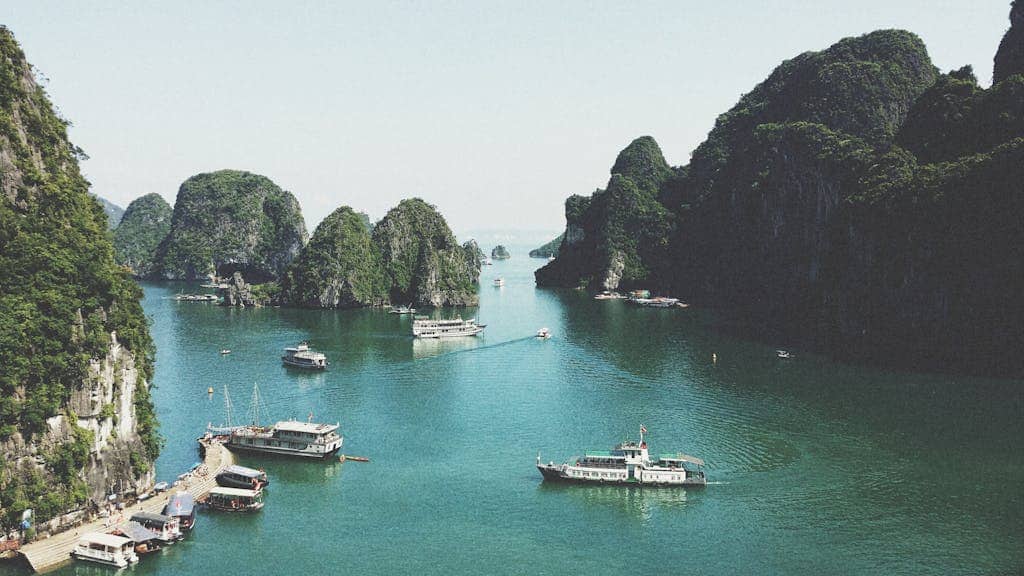
Northern Vietnam: Mountains, Cities, and Cultural Treasures
The north is where Vietnam’s four-season personality really shines.
You’ve got Hanoi with its incredible street food scene, the otherworldly beauty of Ha Long Bay, and mountain adventures in places like Sapa that’ll take your breath away (literally, thanks to the altitude).
Best Time to Visit: Late September through early November is pure magic. The oppressive summer heat has lifted, but you haven’t hit the chilly winter months yet.
Smart Planning Tips:
- Layer like a pro: Even in autumn, mornings can be misty and cool while afternoons warm up nicely
- Book Ha Long Bay cruises in advance: Good weather means everyone wants to be on the water
- Pack for altitude: If you’re heading to Sapa or other mountain areas, bring warmer clothes than you think you’ll need
Hidden Benefits of Visiting Northern Vietnam in Autumn:
- Street food is at its absolute best when the weather’s comfortable for wandering.
- Clear skies mean Ha Long Bay’s limestone karsts look like something from another planet.
- Locals are more active and social when the oppressive summer heat breaks.
- Photography conditions are ideal with soft, clear light.
What to Avoid:
- July and August bring heavy rains and stifling humidity that can make outdoor activities uncomfortable.
- Winter months (December-February) can be surprisingly chilly and drizzly.
Central Vietnam: Where History Meets the Sea
Central Vietnam is the country’s cultural heartland, home to ancient imperial cities, UNESCO World Heritage sites, and some of the most beautiful coastline you’ll ever see.
Hue, Da Nang and Hoi An each offer unique experiences, but timing your visit right is crucial here.
Best Time to Visit: February through April gives you the perfect balance of warm days, cool evenings, and minimal rain.
Strategic Planning Approach:
- Storm Season Awareness: Central Vietnam can be hit by typhoons between September and November, so monitor weather patterns if you’re visiting during these months.
- Festival Coordination: Hoi An’s monthly lantern festival is magical, but plan around the lunar calendar for the best experience.
- Beach Strategy: March and April offer ideal beach conditions without the scorching heat of summer.
Unique Advantages of Perfect Timing:
- Ancient temples and imperial sites are comfortable to explore without excessive heat.
- Coastal activities like snorkeling and beach time are at their peak.
- Local festivals are in full swing with pleasant weather enhancing outdoor celebrations.
- River activities along the Perfume River in Hue are delightful.
Practical Benefits You’ll Love:
- Hotel prices are reasonable before peak season kicks in.
- Restaurants with outdoor seating are actually enjoyable.
- Walking tours don’t leave you exhausted from heat and humidity.
- Photography lighting is consistently good throughout the day.
Southern Vietnam: Tropical Energy and Urban Adventures
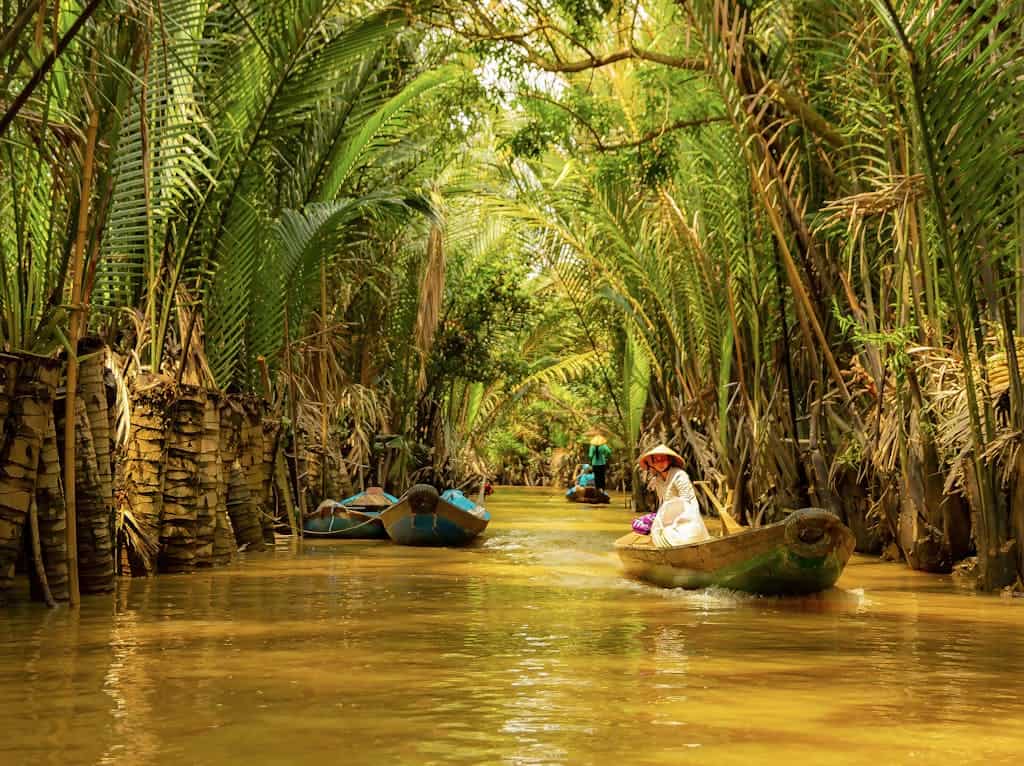
The south is Vietnam’s tropical playground, where the energy never stops and the weather stays consistently warm.
Ho Chi Minh City (still called Saigon by many locals) pulses with life, while the Mekong Delta offers a completely different pace and perspective.
Best Time to Visit: December through April offers the most comfortable combination of warm temperatures and manageable humidity.
Insider Strategies:
- Beat the heat: Schedule outdoor activities for early morning (before 9 AM) or late afternoon (after 4 PM).
- Embrace the rain: Brief tropical showers are refreshing and part of the experience – just carry a compact umbrella.
- Hydration is key: You’ll sweat more than you think, even in “cool” weather.
Why Timing Matters in the South:
- Mekong Delta boat tours are most comfortable when temperatures are moderate.
- Street food exploration is more enjoyable when you’re not melting from heat.
- Urban walking tours of Ho Chi Minh City become manageable rather than endurance tests.
- Air conditioning costs for accommodation are lower during cooler months.
Smart Southern Vietnam Hacks:
- Book accommodations with good air conditioning and pools.
- Pack lightweight, breathable fabrics that dry quickly.
- Plan indoor activities (museums, shopping) for the hottest parts of the day.
- Always carry sunscreen – the tropical sun is no joke.

Vietnamese festivals aren’t just events – they’re immersive cultural experiences that can transform your entire trip. But they also require strategic planning to navigate successfully.
The Festival Calendar That Matters
Tet (Lunar New Year) – January/February: This is the big one.
Imagine Christmas, New Year’s, and family reunions all rolled into one massive celebration. While many businesses close, the cultural experience is unmatched.
Benefits of Visiting During Tet:
- Witness authentic family traditions and community celebrations.
- Experience Vietnam at its most festive and decorated.
- Unique photography opportunities with elaborate decorations.
- Special festival foods available only during this time.
Tet Survival Tips:
- Book everything (flights, hotels, tours) months in advance.
- Expect higher prices and limited availability.
- Carry cash as many ATMs run out during the holiday.
- Be patient with transportation delays and closures.
Mid-Autumn Festival – September/October: Perfect timing for comfortable weather and beautiful lantern displays, especially in northern Vietnam.
Hoi An Lantern Festival – Monthly: Times with the full moon each month, creating magical evenings in this ancient town.
Regional Festival Benefits:
- Authentic cultural immersion that guidebooks can’t provide.
- Incredible food experiences with special festival dishes.
- Unique shopping opportunities for traditional crafts.
- Photography that captures Vietnam’s soul, not just its sights.
Festival Planning That Actually Works
Book Accommodation Early: Popular destinations fill up quickly during major festivals, and prices can double or triple.
Embrace Local Customs: Learn basic Vietnamese greetings and customs. Locals appreciate the effort and it enhances your experience.
Stay Flexible: Festival schedules can change based on lunar calendars or weather, so build buffer time into your plans.
Cultural Etiquette That Matters:
- Dress modestly when visiting temples during festivals.
- Ask permission before photographing people in traditional dress.
- Try to learn about the cultural significance rather than just treating it as entertainment.
- Participate respectfully when invited to join celebrations.
Vietnam Travel Guide Practical Planning
Packing Strategies That Actually Work
Forget generic packing lists – here’s what you really need based on Vietnam’s specific challenges and opportunities:
The Climate-Smart Wardrobe:
- Lightweight, quick-dry fabrics: Essential for humidity and sudden rain showers.
- Layering pieces: For air-conditioned spaces and cooler evenings.
- One warm layer: Even in the south, air conditioning can be aggressive.
- Comfortable walking shoes: With good grip for wet surfaces.
- Waterproof day pack: For electronics and documents during sudden downpours.
Health and Comfort Essentials:
- High-SPF sunscreen: The tropical sun is stronger than you think.
- Insect repellent: Especially for rural areas and evening activities.
- Electrolyte tablets: For the inevitable dehydration from heat and activity.
- Basic medications: Stomach issues are common when trying new foods.
- Reusable water bottle: With a good filter if you’re concerned about tap water.
Tech and Travel Gear:
- Portable phone charger: Long days of navigation and photography drain batteries.
- Universal adapter: Vietnam uses Type A, C, and G plugs.
- Waterproof phone case: For boat trips and unexpected rain.
- Offline maps: Download Google Maps offline for areas with poor internet.
Smart Itinerary Building
The Realistic Approach: Don’t try to see everything in one trip. Vietnam rewards depth over breadth, and rushing between destinations means missing the subtle experiences that make travel memorable.
Strategic Route Planning:
- North to South or South to North: Both work, but consider your energy levels and climate preferences.
- Transportation Buffers: Build extra time for travel between regions – Vietnamese roads can be unpredictable.
- Activity Balance: Mix high-energy sightseeing with relaxation time.
- Local Insights: Plan some unstructured time to follow local recommendations.
Budget-Smart Strategies:
- Book flights in advance: But leave ground transportation flexible.
- Mix accommodation types: Splurge on a few special places, save on others.
- Eat where locals eat: Street food isn’t just cheaper – it’s often better.
- Use local tour operators: They offer better prices and cultural insights than international companies.
Money Matters and Budget Optimization
Daily Budget Reality Check:
- Budget travelers: $25-40 per day (hostels, street food, local transport).
- Mid-range comfort: $50-80 per day (nice hotels, mixed dining, private tours).
- Luxury experience: $100+ per day (high-end accommodations, fine dining, private guides).
Money-Saving Strategies That Don’t Compromise Experience:
- Eat breakfast at your accommodation: Many places include excellent breakfast spreads.
- Use ride-sharing apps: Grab is reliable and shows prices upfront.
- Book directly with hotels: Often cheaper than booking sites, plus you can negotiate.
- Travel like locals: Use public buses for longer distances when time allows.
Smart Spending Priorities:
- Splurge on unique experiences: Cooking classes, private tours of special places.
- Save on routine expenses: Transportation, basic meals, standard accommodations.
- Invest in comfort: Good shoes, quality luggage, reliable gear.
Hidden Gems and Insider Knowledge Vietnam
The Experiences Most Tourists Miss
Northern Vietnam Secrets:
- Bac Ha Market: Only on Sundays, but offers authentic hill tribe culture without the tourist crowds of Sapa.
- Pu Luong Nature Reserve: Incredible terraced rice fields with fewer visitors than Sapa.
- Local coffee culture: Vietnamese coffee isn’t just about the caffeine – it’s a social experience. ☕
Central Vietnam Discoveries:
- My Son Sanctuary at sunrise: Visit early to avoid crowds and experience the spiritual atmosphere.
- Motorcycle tours of Hai Van Pass: One of the world’s most scenic coastal drives.
- Hue’s royal tombs: Each emperor’s tomb reflects his personality – they’re all different and fascinating.
Southern Vietnam Alternatives:
- Can Tho floating markets: Go early morning for the most authentic experience.
- Cu Chi Tunnels: Book a tour that includes the shooting range for a more complete historical perspective.
- Saigon’s rooftop bars: Perfect for watching the city’s energy from above.
Local Wisdom That Transforms Your Experience
Communication Hacks:
- Learn numbers in Vietnamese – essential for bargaining and ordering.
- Download Google Translate with camera function for menu reading.
- Carry a business card from your hotel in Vietnamese for taxi drivers.
Cultural Insights:
- Vietnamese people are incredibly proud of their country – show genuine interest in their culture.
- Tipping isn’t expected but is appreciated for good service.
- Business cards should be received with both hands as a sign of respect.
Safety and Comfort Tips:
- Traffic looks chaotic but follows its own logic – cross streets slowly and predictably.
- Bargaining is expected in markets but not in restaurants.
- Keep copies of important documents in multiple places.
Advanced Planning Resources
Digital Tools That Actually Help
Essential Apps:
- Grab: For reliable transportation with upfront pricing.
- Google Maps: Download offline maps for areas with poor internet.
- XE Currency: For real-time exchange rates and spending tracking.
- TripAdvisor: For recent reviews and local insights.
Useful Websites:
- Vietnam Tourism Official Portal: For current travel regulations and updates.
- Lonely Planet Vietnam: Comprehensive destination guides and practical tips.
- Vietnam Travel Forums: Real traveler experiences and current conditions.
- Weather Underground: More accurate local forecasts than general weather apps.
Vietnam: Planning Timeline for Success
6 Months Before:
- Research visa requirements and apply if necessary
- Book international flights for better prices
- Research accommodations in popular areas
- Start learning basic Vietnamese phrases
3 Months Before:
- Book accommodations in major cities and popular destinations
- Research and book any special experiences or tours
- Check health requirements and get necessary vaccinations
- Purchase travel insurance
1 Month Before:
- Confirm all bookings and print important documents
- Pack and check equipment (cameras, chargers, etc.)
- Research current weather conditions and local events
- Exchange some money to Vietnamese dong
1 Week Before:
- Check in for flights
- Download offline maps and essential apps
- Pack appropriate clothing based on current weather forecasts
- Confirm airport transportation
Making the Most of Your Vietnam Adventure
Vietnam rewards travelers who approach it with curiosity, flexibility, and respect.
The country’s rapid development means change is constant, but its core culture remains deeply rooted in tradition and community.
The Mindset That Matters: Embrace the unexpected.
Your best Vietnam stories will probably come from the moments you didn’t plan – the impromptu invitation to a family dinner, the festival you stumbled upon, the conversation with a local that changed your perspective on the place.
Cultural Appreciation Tips:
- Try to understand the historical context of what you’re seeing
- Support local businesses and artisans when possible
- Be patient with language barriers – effort is appreciated more than perfection
- Show respect at religious sites and during cultural ceremonies
Sustainable Travel Practices:
- Choose accommodations and tour operators with good environmental practices
- Minimize plastic use – carry a reusable water bottle and shopping bag
- Respect local customs and environments
- Support local communities through authentic experiences rather than exploitative tourism
Remember, the “best” time to visit Vietnam is ultimately the time that works for your schedule, budget, and interests. While this guide provides the framework for optimal timing, your perfect Vietnam experience will be uniquely yours.
Final Thoughts: Your Vietnam Journey Awaits
Vietnam isn’t just a destination – it’s an experience that challenges your assumptions, delights your senses, and creates memories that last a lifetime.
Whether you’re drawn by the incredible food scene, the rich history, the stunning landscapes, or simply the adventure of exploring a dynamic culture, Vietnam delivers in ways that consistently surprise travelers.
The key to a successful Vietnam adventure lies in balancing preparation with spontaneity.
Use this guide to make informed decisions about timing, regions, and logistics, but leave room for the unexpected discoveries that make travel truly transformative.
Your journey through Vietnam will be unlike anyone else’s, and that’s exactly as it should be.
The country’s diversity ensures that every traveler finds their own version of Vietnam magic – whether that’s watching the sunrise over Ha Long Bay, learning to cook pho in a local kitchen, exploring ancient temples in perfect weather, or simply sitting in a sidewalk café watching the world go by.
Start planning, but don’t over-plan. Vietnam’s greatest gift to travelers is teaching the art of going with the flow while staying true to your own travel style and interests.
Frequently Asked Questions
What’s the absolute best time to visit Vietnam if I can only go once?
If you’re looking for the sweet spot that works across all regions, aim for March-April or October-November. These shoulder seasons offer comfortable weather in most areas, reasonable prices, and good availability. March-April is particularly great for central and southern Vietnam, while October-November favors the north.
How much does timing really affect my budget?
Timing can impact your budget by 30-50% in popular destinations. Peak season (December-February) sees higher accommodation prices and more expensive tours, while shoulder seasons offer better value without sacrificing experience quality. Festival periods like Tet can double or triple prices in some areas.
Can I really enjoy Vietnam during the rainy season?
Absolutely! The rainy season brings lush landscapes, fewer crowds, and lower prices. Most rain comes in short, heavy bursts rather than all-day downpours. Pack appropriate gear, build flexibility into your schedule, and you might find the rainy season offers a more authentic, less touristy experience.
How far in advance should I book my Vietnam trip?
For optimal pricing and availability, book international flights 2-3 months ahead and accommodations 1-2 months in advance. During peak seasons or major festivals, book even earlier. However, Vietnam’s tourism infrastructure can handle last-minute travelers – you’ll just pay more and have fewer choices.
Is it worth visiting Vietnam during festivals even with the crowds and higher prices?
Festival periods offer irreplaceable cultural experiences that justify the extra cost and crowds for many travelers. You’ll witness authentic traditions, enjoy special foods, and participate in celebrations that locals remember for years. Just be prepared for the logistics and budget accordingly.
What’s the biggest mistake travelers make with Vietnam timing?
The most common mistake is trying to visit too many regions in too short a time, especially during challenging weather. Vietnam rewards slower travel – spending more time in fewer places allows you to experience the culture beyond just ticking off sights. Also, many travelers underestimate how much climate varies by region and pack inappropriately.
